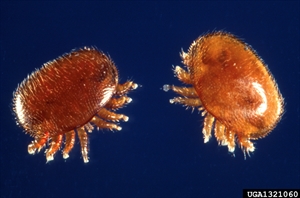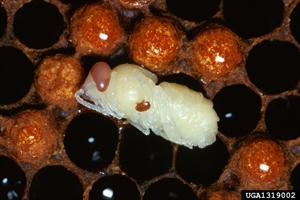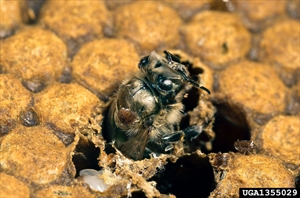Varroa mite
Pacific Pests, Pathogens, Weeds & Pesticides - Online edition
Pacific Pests, Pathogens, Weeds & Pesticides
Varroa (destructor) mite (327)
Varroa destructor; previously the mite was known as Varroa jacobsoni, but in 2000 molecular analysis discovered that there were two species (see Fact Sheet no. 326). The effect of the mite on the European honeybee is referred to as 'varroosis of honey bees'.
Asia, Africa, North, South and Central America, the Caribbean, Europe, Oceania. It is recorded from Australia (from 2022 & under eradication), French Polynesia, New Caledonia, and New Zealand.
The distribution of the mite increased greatly after colonies of the European honeybee were taken to Asia and became infested with the mite from Varroa jacobsoni. This occurred in the last 50-100 years (possibly in the 1950s).
European honeybee, Asian honeybee (minor host).
Infestations of Varroa destructor are invariably serious leading to a disease known as 'varroosis'. There have been suggestions that the mite is a factor in 'colony collapse disorder' when most of the workers disappear. Varroa mites can also spread viruses, further affecting the health of colonies. In fact, there is speculation that the viruses not the mites are the cause of most damage to the bees.
Varroa destructor usually takes some time before being noticed within a colony, sometimes up to 2 years. However, severe infestations lead to:
- 'Spotted-brood pattern' - empty brood cells (where larvae and pupae develop) caused by workers removing the infested brood from their cells.
- Weak bees that do not live long, but which may spread the mite as they naturally rob nectar and honey from other colonies when nectar is scarce, and drift between colonies, i.e., they originate from one colony but take up residence in another.
- Virus (e.g., Deformed wing virus) and bacterial infections (e.g., European and American foulbrood. The mites are mobile so as they move between the bees of the colony they spread disease.
- Crippled bees (stunting, damaged wings, legs, abdomens) that cannot fly properly and can only crawl. The bees also show open wounds, and they become prone to infections.
- Colony decline until all are dead within 1 to 3 years.
The adult female mite is reddish-brown, while the male is white. They are flat, oval, 1–1.8 mm long, 1.5–2 mm wide (Photos 1&2). Adult males are smaller. On adult bees, the mites occur on the thorax or in the abdominal folds.
Varroa destructor reproduces on the larvae of drones and workers of the European honeybee. The bees do not have the grooming behaviour of the Asian honeybee. The latter, can detect and remove the mites from worker bee brood cells.
One or two female varroa mites enter a brood cell before it is capped (closed) and lay 5-6 eggs each, which are difficult to see with the unaided eye. The newly hatched nymph mites feed on the bee larvae and pupae (Photo 3). Once nymphs mature, they mate and the male dies. The females attach themselves to adult bees and feed off their haemolymph (blood) (Photo 4). They emerge from the brood cells with the honeybees (Photo 5).
The rate of increase in the mite population depends on the number of females present, the type of brood (whether drone or worker), and how long brood is available throughout the year. More female mites are produced in drone cells than worker as they take 3 days longer to mature than workers.
Spread occurs easily within the hive as the mites are mobile. After emerging, they may remain attached to the original adult, fall off and find other adults to infest, or enter a brood cell. They may spread in other ways: (i) bees infested with mites enter neighbouring hives to rob nectar; (ii) bees enter the hives of other colonies by mistake - they drift into another colony; or (iii) when beekeepers place infested 'combs' (hexagonal cells where queens lay eggs) in healthy hives. Long distance spread may also occur during swarming. They may be dispersed, too, by bumblebees (Bombus species), although they do not reproduce on them.
The mites live for about 2-3 months. When the colony is not breeding and brood is absent, the mites survive fastened to adults, feeding on their haemolymph (although recent research suggests that they are feeding on the liver - the mites produce saliva that liquefies it). They are obligate parasites of honeybees and do not survive long away from the host.
Varroa destructor is responsible for the death of European honeybees and the collapse of colonies wherever it is present worldwide. Millions of colonies have been destroyed and billions of dollars lost. Economic consequences are large: apart from loss of honey, there is the risk to crop pollination. A third of the crops eaten by human are pollinated by insects, of which 80% are European honeybees. Further, mite transmit viruses, increasing their impact further.
There are accepted ways of monitoring for mites, and three methods are provided. Early detection and reporting is important as it improves the chances of containing and eradicating introductions, therefore, monitoring should be done quarterly at least:
Method 1 (Uncapping drone cells)
- Uncap 100 drone brood cells and remove pupae, and examine each one for mites.
- Check for mites that have fallen from the pupae to the bottom of the drone brood cells.
- Do this on three frames in several hives selected at random.
Method 2 (Sugar shaking)
- Add 1 tablespoon icing sugar and approximately 300 bees (half a cup) and place in a jar with 1/8 inch gauze for a lid.
- Roll or gently shake the jar for 2-3 minutes.
- Leave for 2-3 minutes and shake again.
- Tip out the sugar through the mesh onto white paper, and look for mites.
- Return the bees to the hive.
- Repeat, sampling at least 5% of the hives on each occasion.
Method 3 (Sticky screens)
- Cover pieces of cardboard with a sticky substance (e.g., Vaseline).
- Cover cardboard with wire mesh (1/8 inch) that has holes too small for bees to pass through.
- Place the cardboard at the bottom of the hive or under a bee's nest.
- Count the number of mites that are caught in 24 hours.
The two species, Varroa jacobsoni and the more damaging Varroa destructor can be separated by DNA analysis.
QUARANTINE
Although widely distributed, there are Pacific island countries, for instance, still free from the introduction of Varroa destructor (and Varroa jacobsoni, and newly discovered strains). Australia is free from the mite, too. Those countries, but also others where varroa mites are already present, may wish to enact legislation and devise codes of conduct to minimise the risk of introduction of exotic bee pests and diseases as well as managing those that are endemic. Such a code, developed in 2016 for Australia is provided as an example: http://beeaware.org.au/wp-content/uploads/2017/05/Australian-Honey-Bee-Industry-Biosecurity-Code-of-Practice.pdf, and the Biosecurity manual for beekeepers: http://www.planthealthaustralia.com.au/wp-content/uploads/2016/02/Biosecurity-Manual-for-Beekeepers.pdf.
CULTURAL CONTROL
There are a number of control measures aimed at commercial beekeepers as well as the general public. Some of these may form part of national biosecurity legislation to contain the entry of varroa mites and the spread of endemic pests.
Surveys and sampling (for purposes of biosecurity):
- Place hives near ports and monitor them regularly for mites.
- Destroy any bees found at wharves and check to see if they are carrying varroa mites.
- Establish capability within biosecurity agencies to collect (and/or receive) samples from all beekeepers each year to check for presence of mites.
- Beekeepers should be encouraged to check their hives regularly, and report immediately any unexpected hive deaths, deformed bees, low larval numbers or larval deaths to biosecurity authorities.
Public awareness to control mites:
- Ensure that beekeepers are aware of the biosecurity threats that exist, both with the introduction of bees from other countries, and the mites (and other pests and pathogens) that they might bring.
Physical methods to control mites:
- Open-screen floors to hives. The mesh floor [1/8 inch (3 mm) holes] allows the mites to pass through as they are removed from adult bees when grooming, but not the bees themselves. This method alone can reduce mite populations by more than 10%.
- Do not use combs from the brood area in the honey area.
Sanitation to control mites:
- Practise good sanitation and hygiene: ensure queen bees and equipment are from trusted sources and are pest free. Ensure that borrowed or second-hand equipment is cleaned and sterilised before use.
- Regularly clean and sterilise all tools, gloves, pallets, and boxes used.
- Replace brood combs (with foundation - made of wax to give bees a base for the honeycomb) every 3 years or before as there may be a build-up of mites. Used combs should be disposed of.
- Inspect brood combs regularly.
RESISTANCE
Russian bees, a strain related to the European honeybee that have very low mite populations in their colonies have been introduced to other countries. Russian queen bees are now becoming popular with beekeepers.
CHEMICAL CONTROL
Treatment of hives and equipment:
There are times when it is necessary to sterilise hives and equipment. This might be when there has been a mite infestation, the hives and equipment are second-hand or before storage. EITHER:
- Place the hives in 1:5 diluted boiling sodium carbonate (washing soda) for 1-2 minutes, wash in clean water and dry. OR
- Place in 0.5% sodium hypochlorite for 20 minutes. (Note, household bleach is about 3%, so add one part bleach to five parts water).
Treatment of mites on the bees:
- Tau-fluvalinate a (synthetic pyrethroid) has been used. The chemical is impregnated in strips which are hung on the brood frames. Here, they provide a slow release of the chemical. It is recommended that they remain in place for 6 weeks only, and also honey should be removed before the use of any chemical methods. Unfortunately, mite resistance to tau-fluvalinate has been documented, and there are effects on the bee population from this chemical, which in other circumstances is used as an insecticide. There is also a suggestion that the chemical increases the effects of Deformed wing virus, especially when first used.
- Thymol (derived from thyme). The product is released as a gel in the hive by placing it in a tray on top of the brood frames. It is a fumigant. Said to have no harmful effect on the colony, but may reduce egg-laying by queens.
- Other commercial products contain thymol with camphor, menthol and eucalyptus oil. A disadvantage is that they may taint the honey!
____________________
When using a pesticide, always wear protective clothing and follow the instructions on the product label, such as dosage, timing of application, and pre-harvest interval. Recommendations will vary with the crop and system of cultivation. Expert advice on the most appropriate pesticide to use should always be sought from local agricultural authorities.
AUTHOR Grahame Jackson
Information from CABI (2015) Varroosis of honey bees. Invasive Species Compendium (https://www.cabi.org/isc/datasheet/109539); and BeeAware. Plant Health Australia. (http://beeaware.org.au/archive-pest/varroa-mites/#ad-image-0); and Biosecurity manual for beekeepers. (https://beeaware.org.au/wp-content/uploads/2019/05/Biosecurity-Manual-for-Beekeepers.pdf); and Varroa mite (2020) Varroa mite detection in Townsville. Department of Agriculture and Fisheries. Queensland Government. (https://www.business.qld.gov.au/industries/farms-fishing-forestry/agriculture/land-management/health-pests-weeds-diseases/pests/invasive-animals/prohibited/varroa-mite); and from Varroa mite. Entomology & Nematology. UF/IFAS, University of Florida. (http://entomology.ifas.ufl.edu/creatures/misc/bees/varroa_mite.htm). Photos 2-4 Scott Bauer, USDA Agricultural Research Service, Bugwood.org. Photo 1 Florida Division of Plant Industry, Florida Department of Agriculture and Consumer Services, Bugwood.org. Photo 5 Stephen Ausmus, USDA Agricultural Research Service, Bugwood.org
Produced with support from the Australian Centre for International Agricultural Research under project PC/2010/090: Strengthening integrated crop management research in the Pacific Islands in support of sustainable intensification of high-value crop production, implemented by the University of Queensland and the Secretariat of the Pacific Community.








